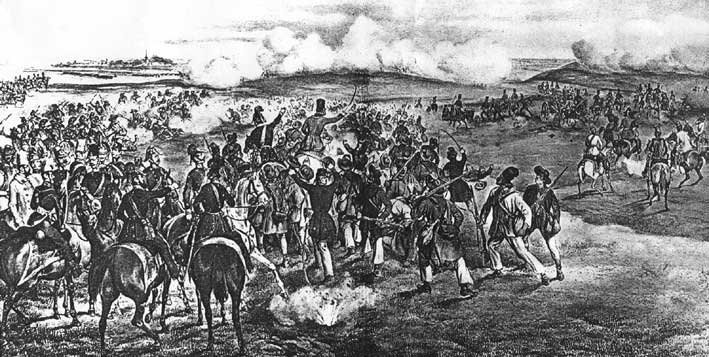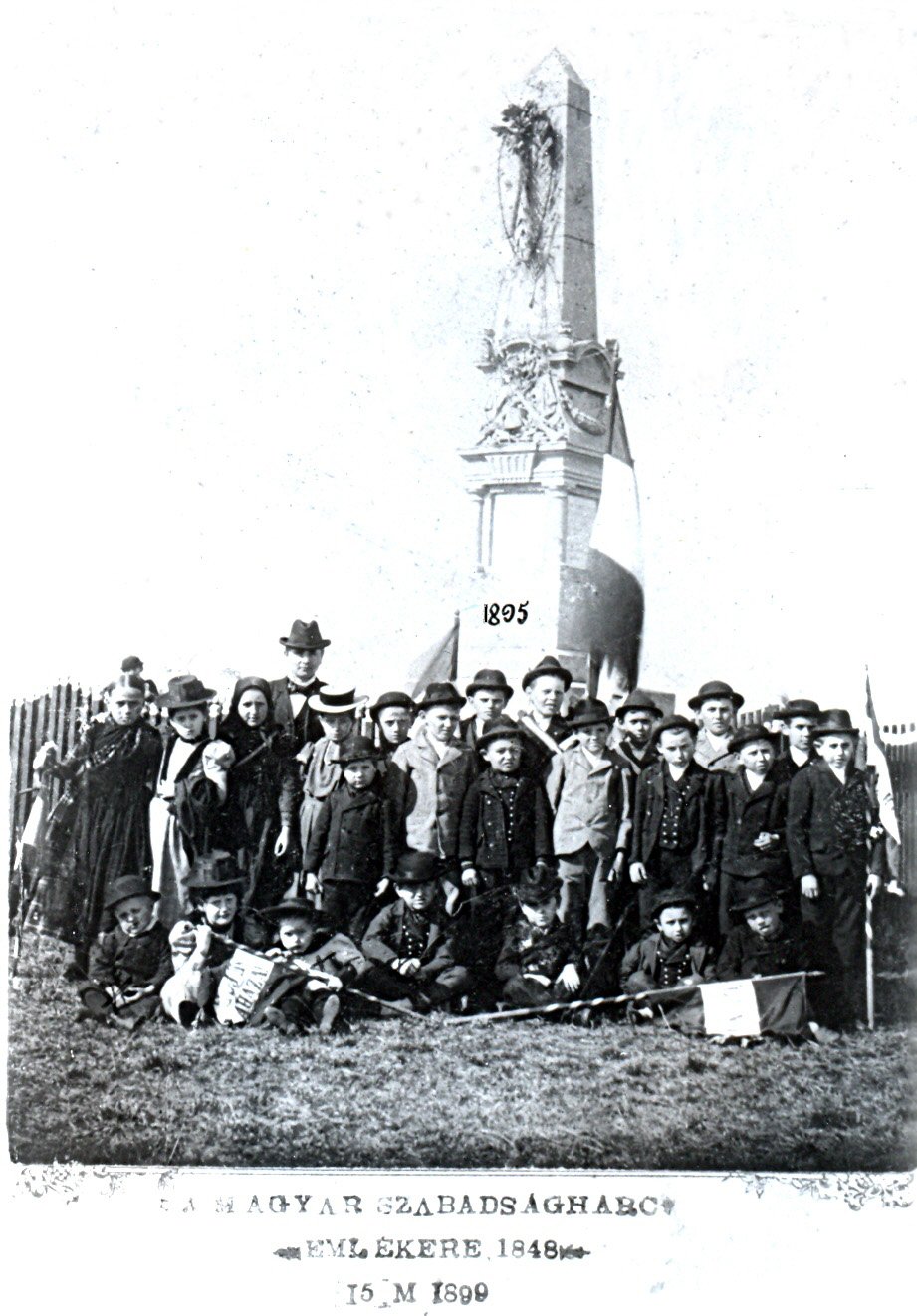 |
 |
This picture is taken from the book "Rat Hrvata s Magjarina 1848-49" (War of the Croatians with the Hungarians 1848-49), Zagreb 1902. It is also portrayed by Johann Jauß in his "Jahrhundertbuch" (centennial book) of the community of Sekitsch with a detailed description of the battle between the Croatian army commander JELLASCHITSCH and Hungarian General GUYON and made by an Austrian lithographer. We see from the picture's caption that the battle allegedly took place near Hedjesch. Many history writers place the battle there, although after Jauß many witnesses of the time confirmed Sekitsch as the place of battle. It is also mentioned that the wounded were treated in Sekitsch and those who died were buried there. What we understand from the picture is that at least it must have been treated as an important battle of the revolutionary years of 1848-49. What else can an Austrian artist document in his artwork, if not its meaning? Jellaschitsch himself described the battle as the most meaningful of his life although he was an underdog. This changed everything, but not the fact that the Hungarian revolutionary army had to stretch their weapons after that.
Document of the battle near Sekitsch. It is especially gratifying that we can now also bring the well-known picture by "Steen" to our historical report about the battle near Sekitsch. The picture was sent to us by Ms. Eve NAGY, born WALLRABENSTEIN, from the USA. Dr. Karl TAUSS wrote of this picture: "On the occasion of the Hungarian freedom fight in the year 1848-49 (in the '48 war) a battle also took place near Sekitsch as it is read on pages 167-200 in the 12th chapter of the "Hundertjährigen Buches" (centennial book) by Johann Jauß. There, where the fallen war heroes were buried a memorial stone was erected in the year 1895 (called "de Steen" in Sekitsch), on which the schoolchildren lay down a wreath every year on the 15th of March with a musical procession led by their teacher.
 |
The above photo was made on March 15th, 1899. She also has a paling which was replaced by iron bars later as it was usual on our cemeteries recognized. In the picture the dress of the children is the most interesting for us: this one rounding hats and the Bakfonernen buttons to the west, only having her like us with old men in memory with the boys. One must this one with headscarf, the different one without headgear, distinguish Sekitscher grown between the clothes of the "sir children" with the flat hats and the two girls with this one dress with the girls with the behind bound chest cloths. The teacher who has taught to 1916 could have been Michael KLEIN.
One recognizes the wire scaffolding of a wreath which probably still was due to the inauguration by de top of the monument. The carried flags don't have to be overlooked either and effort with unifier has even its inscription "Eljen are Magyar" united on this one impose. I also have co-marched in the ordered procession of the schoolchildren in my schooldays once on March 15th.
We carried a red white green armband and a cockade in the buttonhole. Flags were help to carried and the music played. It was fine spring weather and the Kulaer lane was dry. For the house Peter's good wine (Nr.1032) the heavy, one-piece gate was shoved aside and the "Steen" could already be seen from there. Did the Richard CSORNAI what then be spoken, haven't we understood?declaimed, is the monument shall tightly remained in memory have been taken down for me of the Yugoslavs after the first World War, standing on the base. My schoolmate, Nikolaus Ohlicher, wants the stones of the monument in the parish rooms in which Ordonanz shacks have seen. In connection with this, I still want to mention that a second memorial stone which probably had also a little to do war with 1848s has still been at Kulaer street. I have often walked to the station, as me, to Werbaßer high school then went and am to "Secklers Sallasch" on the left of it. Train court street on this stone approached. He stood perhaps 20-25 meters further on the right of the street which led to Kula. However, I cannot remember any more what stood written on this; it was Hungarian.
 |
In the night of the 20th on the 21st of July 1936 the Olympic torch was ignited. |
In his history, our Sekitsch was perhaps never pulled up to the pulse of the history as near as in the year 1936 before when the 11th Olympic Games have taken place in Berlin. But not approximately because active athletes would have been involved in the Olympic Games from Sekitsch. Certainly not. It was rather the fact that the way of the Olympic fire which was carried by Athens to Berlin by land ran through Sekitsch exactly. It was this fact which connected Sekitsch with the historical event on the narrowest one. Furthermore it still was of special importance that Sekitscher athletes carried the Olympic fire on this stretch of 3000 kilometers. Relay race it was only three athletes from Sekitsch, this honor or this luck fell these but after all, Sekitsch was involved in this greatest one, the history has which known up to the year 1936. For twelve days and nights the Olympic fire from Athens was carried by Europe. Kilometer followed after kilometer and at the end the fire had put 3000 kilometers back. It this was an event, this not only the world but our dreamy also had moved sec table exceptionally in this frame. On Sekitsch which had by the district Sekitsch on the way to carry the fire between Novi Sad and Subotica three kilometers of this long way had been dropped at that time and Sekitsch consequently was allowed to put three athletes down. The notary then had to decide who was allowed to carry the fire and his decision was made on Paul Ohlicher, Hans Karbiner and Philipp March.
At that time, first, the one thousand meters which we had to run prepared us to runners because this distance already seemed us almost astronomically, some worries! With a certain industriousness we, however, made it anyway and mill became evening for evening to Hunsingers started and run in the direction of the Vadas.
The Olympic fire then came by Sekitsch on July 29th, 1936. We runners and completely Sekitsch had a temperature contrary to the event. It didn't come on the day but in the middle of the night. One initially was disappointed with it because one had thought to see more on the day. Against this the experience was much more profound and more impressive at night. It became an impressive event for the three runners and the spectators. Already in the early evening had begun our musicians in the main street in different places of the way and played for the conversation open as this belonged to himself in Sekitsch just so. The main street was, the expectant the event entgegenfieberten from the beach up to the Hegyescher cemetery full of people. We runners were completely dressed in white. I still remember quite exactly that wanted nothing more for me in the evening at dinner with loud excitement down the neck. My mother, thought, got around "ihren Bu" thought, got: "Eß nare mei Bu, sunscht fallscht schun no 500 Meter zamme, weil´d ke Kraft me hascht"! I didn't collapse and also had strength.
Because nobody knew how to predict the arrival of the fire, was to against unrest tormenting midnight in Sekitsch and vicious remarks went. This one said one: "In Sentamarsch han die Race 's Feier ausgehn geloßt un des werd nix meh"!
Life arose then toward 0.30 hours and everything was tense. Paul Ohlicher had taken the fire first on the beach of the Feketitschern. I will never forget it when a whispering through the crowd suddenly went and Paul with a measured trot in glaring light dipped at red fox Apothek came down the slope and shone in his white gown. The change turned excellently and I carried the Olympic fire.
I thought the floor swayed below my feet, I was so moved and I ran the one thousand meters with the torch in the hand as if I were relieved of every earth heaviness as if I were carried by wings. I think I wouldn't have the torch only the one thousand meters but five thousand and more meters usedly without getting tired. I heard all possible shouts from the mass of the spectators who continuously applauded.
I hear the shout of an old woman of the roadside certainly today:
"Jani tummel Dich mei Bu, sunscht fallscht zamme. Du bischt jo schun ganz bleech (blaß)"!
I changed March with Philipp at the Hegyescher cemetery which then finally passed the fire on to the Hegyescher.
Our friend Ludwig Schneider was gone by the bicycle and an ax on the porter the whole stretch of road to chop the magnesium torch off after the change because one couldn't put the fire of the magnesium out. I remember quite exactly that many men had come to the place of the change to "light her cigarettes at the Olympic fire"!
Every runner got a silver steel stand as pay for his playing a part with the torch. Furthermore we received a document from the Olympic Kommitee in Berlin about the participation in the torch run signed by the president of the Olympic Kommitees, undersecretary Dr. Theobald Lewald. We kept this single present in our apartment and it always had a special special place for a long time. The memory of this unforgettable experience which as is well known moved the whole world will be in the position to be blotted out ever hardly because the impressions were so tremendous and because we were young boys with a time so near connected to an event!